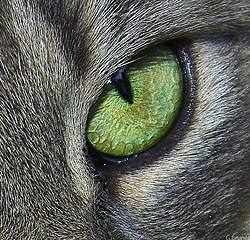Conjunctivitis is a common problem in cats. The most common causes of conjunctivitis are infections. Feline herpesvirus (FHV-1), Chlamydophila felis (C. felis), and Mycoplasma felis (M. felis) are the most common infectious agents present. PCR analysis has the highest sensitivity along with high specificity and is usually the preferred method for diagnosis. The objectives of this study were to describe the cytological findings in cats with conjunctivitis and compare the findings with the results of PCR analysis for these three main infectious agents. Conjunctival smears from 88 cats with conjunctivitis and 10 healthy control cats were evaluated.
 Infectious agents identified by PCR analysis were FHV-1 in 9 cats, C. felis in 8 cats, and M. felis in 6 cats. All 8 cats that were positive for C. felis by PCR testing had epithelial inclusions interpreted as chlamydial inclusions on conjunctival smears. PCR analysis also detects potential co-infection of C. felis with M. felis and FHV-1. The cytological examination of samples from cats with and without M. felis infections resulted in both false positive and negative diagnoses. Therefore, cytological examination was not a highly specific or sensitive diagnostic test for M. felis infection. Many inflammatory cells were present in conjunctival smears from all cats infected with C. felis. This would support the finding that the absence of inflammation makes the diagnosis of C. felis infection unlikely. When many typical inclusions of C. felis are found, cytological examination can be diagnostic, but not when inclusions are considered “suspicious”. Finding eosinophils in conjunctival smears may be an indication to perform PCR testing for FHV-1. Viral inclusions of FHV-1 were not found in specimens stained with Romanowsky stains. Researchers found the effectiveness of cytologic diagnosis is greatly affected by the quality of the smears. [VT]
Infectious agents identified by PCR analysis were FHV-1 in 9 cats, C. felis in 8 cats, and M. felis in 6 cats. All 8 cats that were positive for C. felis by PCR testing had epithelial inclusions interpreted as chlamydial inclusions on conjunctival smears. PCR analysis also detects potential co-infection of C. felis with M. felis and FHV-1. The cytological examination of samples from cats with and without M. felis infections resulted in both false positive and negative diagnoses. Therefore, cytological examination was not a highly specific or sensitive diagnostic test for M. felis infection. Many inflammatory cells were present in conjunctival smears from all cats infected with C. felis. This would support the finding that the absence of inflammation makes the diagnosis of C. felis infection unlikely. When many typical inclusions of C. felis are found, cytological examination can be diagnostic, but not when inclusions are considered “suspicious”. Finding eosinophils in conjunctival smears may be an indication to perform PCR testing for FHV-1. Viral inclusions of FHV-1 were not found in specimens stained with Romanowsky stains. Researchers found the effectiveness of cytologic diagnosis is greatly affected by the quality of the smears. [VT]See also: Gould D. Feline herpesvirus-1: ocular manifestations, diagnosis and treatment options. J Feline Med Surg. 2011; 13: 333-46.
Related blog articles:
Treatment of feline herpesvirus (Feb 2009)
Pradofloxacin for feline upper respiratory tract disease (March 2008)
More on cat health:
Winn Feline Foundation Library
Find us on Facebook
Follow us on Twitter
Join us on Google+
No comments:
Post a Comment